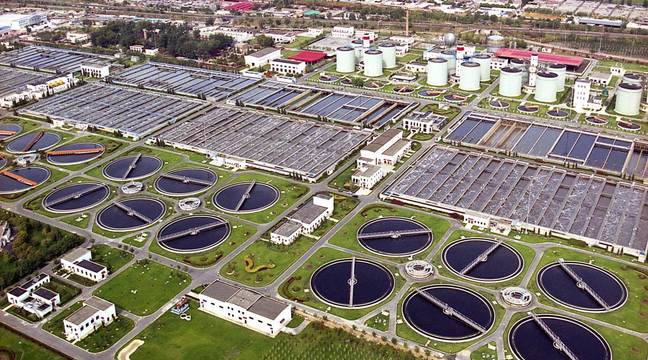
当前课程知识点:Water and Wastewater Treatment Engineering: Biochemical Technology > Chapter 0 Introduction > Section 0.1 Development Status of Wastewater Treatment Process > Section 0.1 Development Status of Wastewater Treatment Process
返回《Water and Wastewater Treatment Engineering: Biochemical Technology》慕课在线视频课程列表
返回《Water and Wastewater Treatment Engineering: Biochemical Technology》慕课在线视频列表
同学们大家好,欢迎大家来到水处理工程MOOC课堂
今天,我们开始讲水处理工程第二篇
废水生物处理工程的原理与技术
我是清华大学环境学院的左剑恶
今天我们先讲绪论,一共有三个问题
第一个是废水生物处理工艺的一些发展现状
第二个是废水生物处理的典型工艺
同时介绍整个课程的主要内容
首先,我们来看一看,为什么要处理水和废水
或者说是为什么要进行水处理
这里面有一张早期,比较早的图片
可以看到我们人类在生活中需要取水
有的时候也需要排泄,排水
在这个早期的时候,取水和排水隔得不太远
所以就会相互有影响
因此,我们就发现就需要做废水处理
同时也需要做给水的处理
当然,随着人类的发展,随着这个城市化的进程
当城市出现以后,就需要有这个排水系统
排水系统,一共有两种类型,一种是合流制
我们在这,可以看到所谓的合流制
是把我们人类生活产生的生活污水以工厂产生的工业废水
以及城市由于道路封闭以后产生的雨水,合在一起
用一根排水管收集起来以后,排到污水处理厂,进行处理
我们可以看到,在城市的地下,实际上有这样的排水管网
通过刚才把这三种废水收集起来以后,进到城市污水进行处理
最后处理以后的水,排到河流
另外一种系统是分流制的系统
分流制的系统实际上是把废水
也就是工业废水和生活污水,统一收集,而把雨水单独收集
污水,或者说是废水,进入污水处理厂进行处理
雨水经过简单的处理以后直接排到这个收纳水体
因此在城市的底部,如果是采用分流制的话
我们就会同时有两套管网系统
一套是红色的,这个污水排水管网,将污水收集到污水处理厂
另外一套是蓝色的,是雨水收集系统,将雨水收集以后直接排到河道
因此,废水生物处理工程,它的基本的内容
我们看,第一,在废水生物处理中间所说的废水
实际上主要指的是,生活污水和城市废水以及工业污水
废水中间的主要污染物,有机物、氮、磷等以及其他的一些污染物
所谓的生物,实际上在这里指的是微生物
主要利用的是其中的细菌,有的时候也会利用一些真菌
或者是一些原生动物或者后生动物
所谓的处理,是采用不同的工艺措施,将废水中间的污染物
经过转换或者分解,加以去除或者是回收
使废水得到处理,使出水的水质达标排放
所谓的工程,指有一定的规模,通过工程的手段得以实施
在废水中间,我们看看主要的一些污染物的来源
对于生活污水来说,它的COD、BOD、氨氮、磷
基本的浓度我们可以看,COD是在400到500
BOD是在200到300,氨氮在40到50,总氮,是在50到60
总磷是在4~8 mg/L
对于工业废水来说,由于工业废水的种类非常的多
水质变化就会非常大,好比说啤酒废水
或者说是酒精废水,味精废水,造纸黑液
它们的COD,差别非常大
什么是废水处理工程
就是要针对废水中不同类型的污染物
采用不用的处理方法和工艺对它进行处理
废水生物处理的对象主要是两大类的污染物
有机物以及营养物质氮和磷
两大类的废水,生活污水或者城市污水,以及有机的工业废水
废水生物处理的主体是微生物
我们在后面会做具体的介绍
废水生物处理的主要的内容,我们用一个例子来说明
我们在这可以看到,有这样的一个例子
一个典型城市污水,水量为500000m3/d
它的COD是400 mg/L,BOD5是200mg/L
氨氮是30,总磷是4mg/L,出水的要求要达到我们中国的国家一级标准
希望,采用这个A/A/O工艺进行处理
当然,具体什么叫A/A/O,我们后面会细讲
希望我们能通过设计和和计算
给出,第一,完整的水处理的工艺流程和污泥的处理流程
这两个相当于是工艺设计
第二,曝气池中间A/A/O三个池子的池容分别是多大
这是相当于工艺计算
结合生物脱氮除磷的原理
解释这个本工艺流程在脱氮除磷方面的具体措施
这相当于是基本的原理
第四是假设该厂经脱水后的污泥
需要用载重5吨的卡车外运
那么问每天那需要运多少车次
这相当于是后期的污泥处理
通过上面的例题,我们就可以发现我们这个课程的主要内容是三个方面
第一是介绍介绍废水生物处理的基本原理
这相当于理论知识
第二是介绍各种主要废水生物处理工艺
这相当于介绍一些工艺常识
第三是介绍与废水生物处理有关的
设计计算、工程设计以及部分的工程案例
这相当于是介绍一部分工程实践
那么下面我们具体来看一下
对于一个生活污水或者是城市污水的处理来看
可以看到原废水它的COD一般是在400(mg/L)左右
BOD一般在200(mg/L)左右,SS在200(mg/L)左右
希望通过我们学的这个废水生物处理的工程
经过处理之后要达到一定的排放标准,好比说国家一级标准
一级A的标准规定了COD要小于等于50(mg/L)
BOD要小于等于10(mg/L),SS小于等于10(mg/L)
当然,我们给大家的例子,可以看到
经过一个工程的处理以后
我们可以让COD达到30(mg/L)左右
BOD达到这个10(mg/L)以下,SS达到10(mg/L)以下
这样的一个水,当然就算是处理干净了
一般的一个典型的城市污水处理厂的工艺流程
我们可以看到,首先,废水进入这个泵房
经过提升以后,通过格栅,通过沉砂池
然后通过初沉池,最后进入这个生物处理系统、曝气池和二沉池
这是我们第二篇水处理工程第二篇要介绍的主要内容
废水生物处理这个部分,前面的沉砂池,沉淀池
黄老师已经给大家做过介绍
通过二沉池之后,这个水就可以直接外排
或者是如果要回用的话,再增加这个深度处理工艺
当然,在生物处理过程中间,还会产生这个剩余污泥
剩余污泥,会经过后续的浓缩和厌氧消化,在厌氧消化过程中间
会将污泥中间的一些有机物变成二氧化碳和甲烷
甲烷是一种可以燃烧的气体,可以回收能源
剩余的污泥,经过脱水以后,外运进行进一步的处理
所以这就是一个典型的城市污水处理厂的工艺流程
-Section 0.1 Development Status of Wastewater Treatment Process
--Section 0.1 Development Status of Wastewater Treatment Process
-Section 0.2 Typical Processes of Wastewater Biological Treatment
--Section 0.2 Typical Processes of Wastewater Biological Treatment
-Section 1.1 Principles of wastewater aerobic biological treatment
--1.1 Principles of wastewater aerobic biological treatment
-Section 1.2 Principles and determination of wastewater biodegradability
--1.2 Principles and determination of wastewater biodegradability
-Section 1.3 Principles of wastewater anaerobic biological treatment
--Section 1.3.1 Principles of wastewater anaerobic biological treatment(1)
--Section 1.3.2 Principles of wastewater anaerobic biological treatment(2)
-Section 1.4 Principles of wastewater biological nitrogen removal
--Section 1.4 Principles of wastewater biological nitrogen removal
-Section 1.5 Principles of wastewater biological phosphorus removal
--Section 1.5 Principles of wastewater biological phosphorus removal
-Chapter 1 Homework
-Section 2.1 Basic concept of activated sludge process
--Section 2.1.1 Basic concept of activated sludge process
--Section 2.1.2 Basic concept of activated sludge process
-Section 2.2 Growth rule of activated sludge and its application
--Section 2.2 Growth rule of activated sludge and its application
-Section 2.3 Running mode of activated sludge process
--Section 2.3.1 Running mode of activated sludge process(1)
--Section 2.3.2 Running mode of activated sludge process(2)
-Section 2.4 Kinetics of active sludge process
--Section 2.4.1 Kinetics of active sludge process(1)
--Section 2.4.2 Kinetics of active sludge process(2)
--Section 2.4.3 Kinetics of active sludge process(3)
--Research and Development of Kinetic Model of Activated Sludge Process
-Section 2.5 Principle, calculation and equipment of aeration
--Section 2.5.1 Principle, calculation and equipment of aeration(1)
--Section 2.5.2 Principle, calculation and equipment of aeration(2)
-Section 2.6 Designing of activated sludge process
--Section 2.6 Designing of activated sludge process
-Section 2.7 Operation and management of active sludge process
--Section 2.7.1 Operation and management of active sludge process (1)
--Section 2.7.2 Operation and management of active sludge process (2)
-Chapter 2 Homework
-Section 3.1 Basic principle of biofilm
--Section 3.1 Basic principle of biofilm
-Section 3.2 Biofilter process
--Section 3.2.1 Biofilter Process (1)
--Section 3.2.2 Biofilter process (2)
--Section 3.2.3 Biofilter process (3)
-Section 3.3 Biodisk process
-Section 3.4 Biological contact oxidation process
--Section 3.4 Biological contact oxidation process
-Section 3.5 Aerobic biological fluidized bed process
--Section 3.5 Aerobic biological fluidized bed process
-Chapter 3 Homework
-Section 4.1 Oxidation ditch process
--Section 4.1 Oxidation ditch process
-Section 4.2 A-B process
-Section 4.3 SBR process
-Section 4.4 MBR process
-Chapter 4 Homework
-Section 5.1 Overview and characteristics of development of anaerobic biological treatment
--Section 5.1 Overview and characteristics of development of anaerobic biological treatment
-Section 5.2 Anaerobic digester
--Section 5.2 Anaerobic digester
-Section 5.3 Anaerobic contact process and anaerobic filter process
--Section 5.3 Anaerobic contact process and anaerobic filter process
-Section 5.4 UASB process
-Section 5.5 Other anaerobic biological treatment process
--Section 5.5 Other anaerobic biological treatment process
-Section 5.6 Operation management of anaerobic biological treatment process
--Section 5.6 Operation management of anaerobic biological treatment process
-Chapter 5 Homework
-Section 6.1 Introduction
-Section 6.2 Biological nitrogen removal process and technology
--Section 6.2 Biological nitrogen removal process and technology
-Section 6.3 Biological phosphorus removal process and technology
--Section 6.3 Biological phosphorus removal process and technology
-Section 6.4 Simultaneous nitrogen and phosphorus removal process
--Section 6.4 Simultaneous nitrogen and phosphorus removal process
-Chapter 6 Homework
-Section 7 Natural biological treatment process
--Section 7 Natural biological treatment process
-Chapter 7 Homework
-Section 8.1 Source, nature and treatment of sludge
--Section 8.1 Source, nature and treatment of sludge
-Section 8.2 Sludge thickening and digestive stability
--Section 8.2 Sludge thickening and digestive stability
-Section 8.3 Sludge conditioning, dehydration and incineration
--Section 8.3 Sludge conditioning, dehydration and incineration
-Chapter 8 Homework
-Section 9 Wastewater Discharge and Reuse
--Section 9 Wastewater Discharge and Reuse
-Chapter 9 Homework
